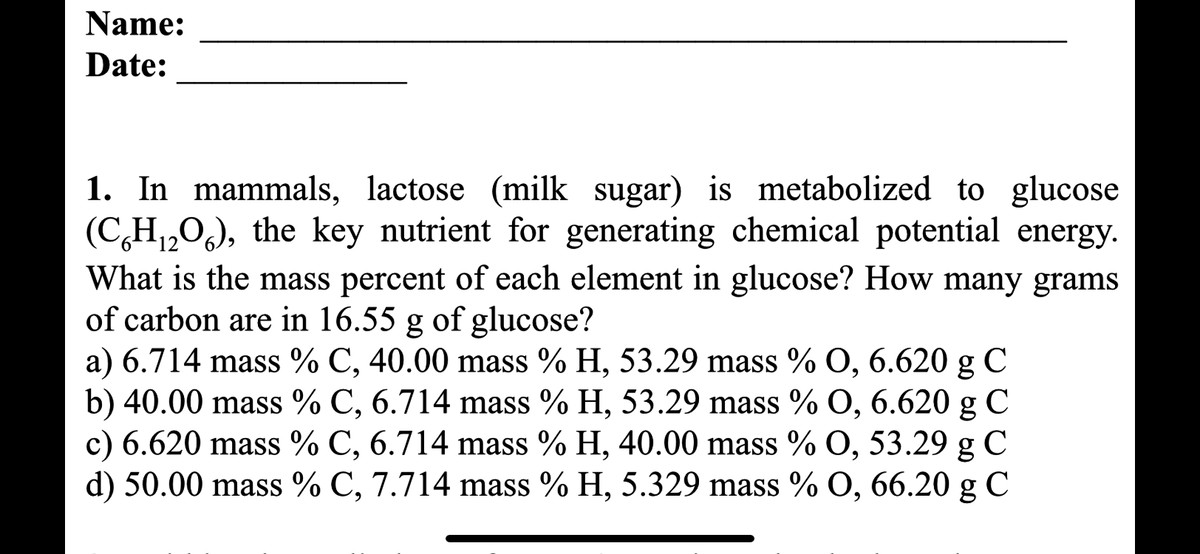12 1. In mammals, lactose (milk sugar) is metabolized to glucose (C6H₁2O6), the key nutrient for generating chemical potential energy. What is the mass percent of each element in glucose? How many grams of carbon are in 16.55 g of glucose? a) 6.714 mass % C, 40.00 mass % H, 53.29 mass % O, 6.620 g C b) 40.00 mass % C, 6.714 mass % H, 53.29 mass % O, 6.620 g C c) 6.620 mass % C, 6.714 mass % H, 40.00 mass % O, 53.29 g C d) 50.00 mass % C, 7.714 mass % H, 5.329 mass % O, 66.20 g C
12 1. In mammals, lactose (milk sugar) is metabolized to glucose (C6H₁2O6), the key nutrient for generating chemical potential energy. What is the mass percent of each element in glucose? How many grams of carbon are in 16.55 g of glucose? a) 6.714 mass % C, 40.00 mass % H, 53.29 mass % O, 6.620 g C b) 40.00 mass % C, 6.714 mass % H, 53.29 mass % O, 6.620 g C c) 6.620 mass % C, 6.714 mass % H, 40.00 mass % O, 53.29 g C d) 50.00 mass % C, 7.714 mass % H, 5.329 mass % O, 66.20 g C
Introductory Chemistry: A Foundation
9th Edition
ISBN:9781337399425
Author:Steven S. Zumdahl, Donald J. DeCoste
Publisher:Steven S. Zumdahl, Donald J. DeCoste
Chapter8: Chemical Composition
Section: Chapter Questions
Problem 128CP: itamin B12 , cyancobalamin, is essential for human nutrition. Its molecular formula is...
Related questions
Question

Transcribed Image Text:Name:
Date:
1. In mammals, lactose (milk sugar) is metabolized to glucose
(C₂H₁2O), the key nutrient for generating chemical potential energy.
12
What is the mass percent of each element in glucose? How many grams
of carbon are in 16.55 g of glucose?
a) 6.714 mass % C, 40.00 mass % H, 53.29 mass % O, 6.620 g C
b) 40.00 mass % C, 6.714 mass % H, 53.29 mass % O, 6.620 g C
c) 6.620 mass % C, 6.714 mass % H, 40.00 mass % O, 53.29 g C
d) 50.00 mass % C, 7.714 mass % H, 5.329 mass % O, 66.20 g C
Expert Solution
This question has been solved!
Explore an expertly crafted, step-by-step solution for a thorough understanding of key concepts.
This is a popular solution!
Trending now
This is a popular solution!
Step by step
Solved in 2 steps

Knowledge Booster
Learn more about
Need a deep-dive on the concept behind this application? Look no further. Learn more about this topic, chemistry and related others by exploring similar questions and additional content below.Recommended textbooks for you

Introductory Chemistry: A Foundation
Chemistry
ISBN:
9781337399425
Author:
Steven S. Zumdahl, Donald J. DeCoste
Publisher:
Cengage Learning

Chemistry: Matter and Change
Chemistry
ISBN:
9780078746376
Author:
Dinah Zike, Laurel Dingrando, Nicholas Hainen, Cheryl Wistrom
Publisher:
Glencoe/McGraw-Hill School Pub Co

Chemistry
Chemistry
ISBN:
9781305957404
Author:
Steven S. Zumdahl, Susan A. Zumdahl, Donald J. DeCoste
Publisher:
Cengage Learning

Introductory Chemistry: A Foundation
Chemistry
ISBN:
9781337399425
Author:
Steven S. Zumdahl, Donald J. DeCoste
Publisher:
Cengage Learning

Chemistry: Matter and Change
Chemistry
ISBN:
9780078746376
Author:
Dinah Zike, Laurel Dingrando, Nicholas Hainen, Cheryl Wistrom
Publisher:
Glencoe/McGraw-Hill School Pub Co

Chemistry
Chemistry
ISBN:
9781305957404
Author:
Steven S. Zumdahl, Susan A. Zumdahl, Donald J. DeCoste
Publisher:
Cengage Learning

Chemistry: An Atoms First Approach
Chemistry
ISBN:
9781305079243
Author:
Steven S. Zumdahl, Susan A. Zumdahl
Publisher:
Cengage Learning


Chemistry by OpenStax (2015-05-04)
Chemistry
ISBN:
9781938168390
Author:
Klaus Theopold, Richard H Langley, Paul Flowers, William R. Robinson, Mark Blaser
Publisher:
OpenStax